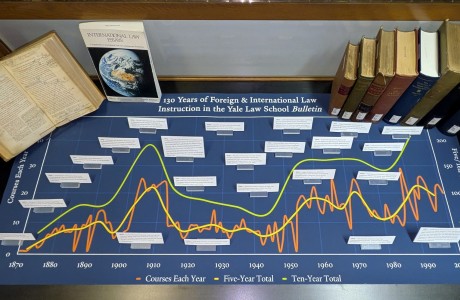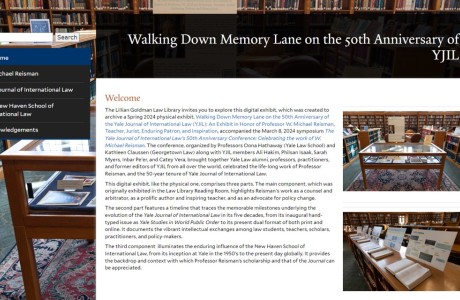Mexico Celebrates its Bicentennial: 1810-2010
From the exhibit, "Mexico Celebrates its Bicentennial: 1810-2010", curated by Teresa Miguel and Michael Widener, and on display in the Rare Book Exhibition Gallery, Level L2, Lillian Goldman Law Library, Yale Law School. All works are part of the Yale Law Library collection unless otherwise indicated.
Hispanic Heritage Month (September 15 – October 15), first proclaimed as Hispanic Heritage Week in 1968, celebrates the Hispanic, Latino, and Chicano cultures of the United States while recognizing the independence of Costa Rica, El Salvador, Guatemala, Honduras, and Nicaragua on September 15, Mexico on September 16, and Chile on September 18.
September 16, 2010, marked the bicentennial of the beginning of Mexican independence from Spain:
About eight o’clock in the morning on September 16, 1810, Father Miguel Hidalgo exhorted a crowd of some 600 men who had come for Mass at the hamlet of Dolores where he was the curate to join him in rebellion; most did. This event, known as the Grito de Dolores (Cry of Dolores), began the eleven years war for Mexican independence.
-- Robert L. Scheina, Latin America’s Wars (2003).
That same autumn, a group of progressive-minded Spaniards and leaders from the Spanish colonies in the Americas began work on a document focusing on the concepts of liberty and equality which eventually became Spain’s first constitution. The Constitution of Cadiz was written during the Peninsular Wars when Spain was wresting away control of its homeland from Napoleon. Several leaders from the Spanish colonies including Mexico, Chile, Peru, and Ecuador, participated in the Cadiz debates. Naturally, they returned to the Americas and influenced the writing of their own constitutions.
Mexico’s Constitution of 1824, the first after achieving independence from Spain, was heavily influenced by the Constitution of Cadiz. Miguel Ramos Arizpe (1775-1843), a Mexican priest and politician, was present in Cadiz and was an active participant in the creation of the Mexican Constitution of 1824, a precursor to Mexico’s current Constitution of 1917. Ramos Arzipe later served as Minister of Justice to four presidents including Antonio Lopez de Santa Anna.
(Photograph courtesy of Tarlton Law Library, University of Texas)
Miguel Hidalgo y Costilla (1753-1811), a Catholic priest and illustrious military general, is considered the Padre de la Patria, or Founding Father, and initiator of its indepen-dence. It was he who organized and led the first group of insurgents in September 1810 in what would be a lengthy but successful fight for independence. In December 1810, Padre Hidalgo, acting as head of the newly established alternative Mexican government in Guadalajara, issued a decree abolishing slavery. He was captured by Spanish forces in January 1811 and rapidly jailed, excommunicated, found guilty of treason, and executed before a firing squad.
The volume below is a tribute to famous Mexican places and people who contributed to the legacy, evolution, and culture of law and justice in Mexico.
El Abogado Mexicano: Historia e Imagen (México: Universidad Nacional Autónoma de México, Instituto de Investigaciones Jurídicas, 1992).
The next work, written the same year as Mexico’s first constitution, is a report by the judges of the Mining Tribunal to the Supreme Executive Power of Mexico on the re-establishment of mining regulations, procedure, protection, promotion, and commerce in Mexico. The Supreme Executive Power had expressly requested recommendations from the Tribunal, which advocated comercio libre or free market in this field.
Memoria acerca de los Medios que se Estiman Justos para el Fomento y Pronto Restablecimiento de la Minería presentada por el Tribunal del mismo cuerpo al Supremo Poder Ejecutivo (Mexico 1824).
Antonio López de Santa Anna (1794-1876) was just 16 years old when he joined the colonial Spanish army to fight against the insurgency of Miguel Hidalgo and the rebel forces. Santa Anna rose quickly through the ranks of the Spanish army, but in 1821, he declared his loyalty to Agustín de Iturbide, a general in the Mexican Army who led the decisive assault on Mexico City to secure Mexico’s independence from Spain. Santa Anna’s life was long and complex. He served as Mexico’s leader eleven times, the first in 1833. He is best remembered as the commander who, in 1836, stormed the Alamo in the Texas Revolution.
In 1845, during his fifth presidency, Santa Anna was arrested by opposition forces and tried for treason. This document is Santa Anna’s plea from San Carlos de Perote prison to the Court to release him and allow him, against his true desire, to leave Mexico. His wish was granted and he was exiled to Cuba shortly thereafter.
Antonio López de Santa Anna, Exposición que el Exmo. Sr. D. Antonio López de Santa-Anna dirige desde la Fortaleza de San Cárlos de Perote á los Exmos. Señores Secretarios de la Cámara de Diputados para que se sirvan dar cuenta en la sesión del Gran Jurado, señalada para el día 24 de febrero del corriente año (Mexico, 1845).
After the Spanish colonies won independence, the law of each newly formed country evolved individually. This early 19th-century lawyer’s manual explains the state of the law in Peru only a few years after its independence (1821). Originally written by law professor Juan Eugenio de Ochoa and printed in Paris in 1827, this second edition was “corrected and improved” by an unnamed “society of friends” and reprinted in Peru in 1830.
Juan Eugenio de Ochoa, Manual del Abogado Americano (Arequipa, Peru, 1830).
Vicente Morales y Duárez (1757-1812) was sent to Cadiz in 1810 to participate along with other representatives from the Spanish colonies in the Cortes de Cadiz. They were the Diputados de Indias, the Deputies from the Americas, and were granted full rights and freedoms to participate in the assembly alongside their counterparts from Spain and the Philippines. Morales y Duárez, who was greatly respected by his colleagues on both sides of the Atlantic, was speci-fically instrumental in the establishment of the Cortes, which was charged with creating a body of laws and ultimately issued the Constitution of Cadiz. He died suddenly in Cadiz of apoplexy shortly after the promul-gation of the Constitution. This volume is a tribute to Morales y Duárez and his short but successful and influential career which helped shape Peruvian constitutional law.
Luis Alayza y Paz Soldán, La Constitución de Cádiz de 1812: El Egregio Limeño Morales y Duárez (Lima, 1946).
Special thanks to Maria Gutierrez, PhD '15, and Jaime Olaiz Gonzalez, JSD '14, for their expert assistance and suggestions.








